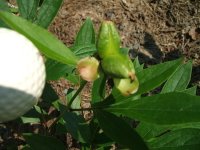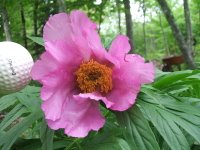 The first is Paeonia anomala (this is subsp intermedia which has wider leaf segments), the Anomalous Peony, probably the most cold-hardy of the species as it's natural range runs the entire length of the Ural mountains of Siberia and it has been naturalized into
The first is Paeonia anomala (this is subsp intermedia which has wider leaf segments), the Anomalous Peony, probably the most cold-hardy of the species as it's natural range runs the entire length of the Ural mountains of Siberia and it has been naturalized into  the Kola Penninsula since about the end of the 1800's. Easy to grow in normal garden conditions and soils, it is adaptable from full sun to the dappled shade of woodland gardens in mixed cover. Indeed its natural environment is in forests and scrub. The species has some variability in the fineness of the leaf segments, and in the colour of the flowers (there is a white-flowered form which I am anxiously awaiting the flowering of); the form most often seen in book photos is narrowly segmented and has dark magenta flowers.
the Kola Penninsula since about the end of the 1800's. Easy to grow in normal garden conditions and soils, it is adaptable from full sun to the dappled shade of woodland gardens in mixed cover. Indeed its natural environment is in forests and scrub. The species has some variability in the fineness of the leaf segments, and in the colour of the flowers (there is a white-flowered form which I am anxiously awaiting the flowering of); the form most often seen in book photos is narrowly segmented and has dark magenta flowers. Second is Paeonia veitchii, Veitch's Peony, of late classified as a subspecies of anomala by some Chinese botanists. It has some overlap with the southern end of the range of anomala and extends further south. Flower colour is variable, most of mine are either slightly
Second is Paeonia veitchii, Veitch's Peony, of late classified as a subspecies of anomala by some Chinese botanists. It has some overlap with the southern end of the range of anomala and extends further south. Flower colour is variable, most of mine are either slightly  paler pink than this plant or a darker pink, but from later seed batches I have been getting plants ranging to dark red. And of course there is a white form which I try to keep the bees from diluting. Leaf variations include shiny smooth leafs to "matte finishes" and veining with an "etched in" appearance. The plant in the photo is from seed from a compact form, but the plant seems about full size in garden conditions.
paler pink than this plant or a darker pink, but from later seed batches I have been getting plants ranging to dark red. And of course there is a white form which I try to keep the bees from diluting. Leaf variations include shiny smooth leafs to "matte finishes" and veining with an "etched in" appearance. The plant in the photo is from seed from a compact form, but the plant seems about full size in garden conditions.Veitchii is one of the few species which has more than one flower bud per stem (it has a terminal bud and 1 to 3 pairs of side-buds). Those who seek large flowers can direct more growth energy to the terminal bud by early removal of the sidebuds, whereas those who leave the sidebuds on get to enjoy a succession of smaller flowers over a couple of weeks, extending the bloom period of the plant. This species is equally easy and adaptable as anomala.
These 2 (or 1 if you prefer) were the first species for which I obtained seed and had success with. They used to be my earliest peonies to flower... How naive I was, then. (okay, still am but that's a different story)
















 Carpels of Paeonia anomala subsp intermedia
Carpels of Paeonia anomala subsp intermedia





